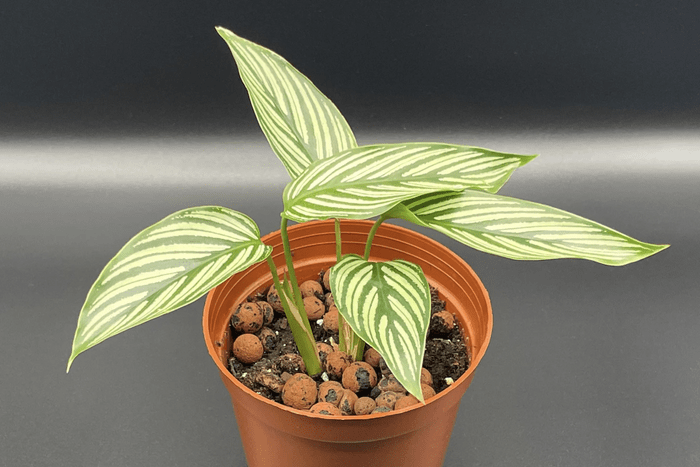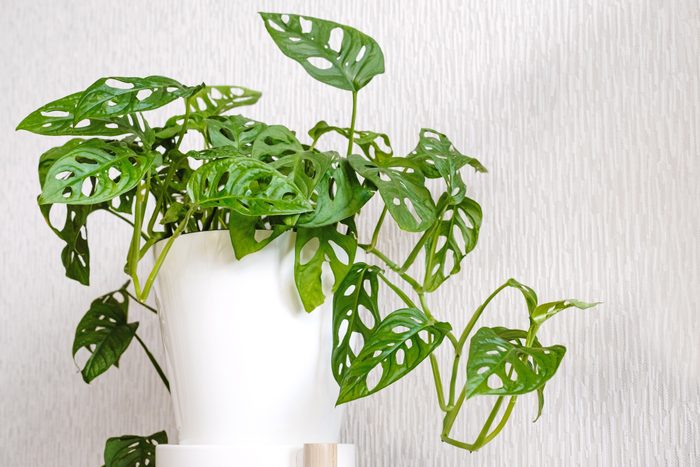Maidenhair Fern for Helicopter Plant Parents
The delicate, lacy maidenhair fern is great for over-attentive plant lovers but a disaster for all others. It requires bright light and consistently moist soil. “Allowing it to dry out is a death knell,” says Steinkoph. “And an east window is perfect.”
Calathea Makayona for Helicopter Plant Parents
Calathea makayona’s large, tropical, waxy leaves evolved to catch dripping water from the rainforest canopy.
“It’s perfect for someone with a communal office space, where you’re either bumping elbows with your partner or your kids and pets are running underfoot,” says Sabharwal. “It helps designate your space from other activities while ensuring that they are non-toxic to everyone around you.”
It likes bright, indirect light and minimal water.
Goeppertias for Helicopter Plant Parents
Formerly called calatheas, these plants offer a jungly vibe and delicate flowers. They’re also finicky, so good for helicopter plant parents. To grow well, they need to be kept moist with elevated humidity, in bright light but out of full sun.
“They also do not like fluorinated water,” says Steinkoph. “If your tap water contains fluoride, use distilled, spring or rainwater.”
Aglaonema for Absent-Minded Plant Parents
Perky aglaonema’s elongated leaves sporting green and yellow patterns add nice texture to any room. They’re easy plants to keep alive because they don’t need a lot of light and their succulent stems can tolerate drying out between waterings. For movie buffs, this is the plant Leon carried with him in The Professional.
Staghorn Fern for Those Who Crave Order
Antler-shaped fronds give staghorn fern character, energy and personality. “It’s perfect for the workspace of someone who can count on one hand all of their objects that spark joy and where everything has a place, from the alphabetized books down to the personalized letterhead and custom cable keepers,” says Sabharwal.
It also craves humidity, so keep the soil moist and shield it from direct light.
Pothos for New and Neglectful Plant Parents
Also called devil’s ivy, this houseplant is popular because it’s so easy to grow. “Pothos can collapse when allowed to dry out, but they usually come back,” Steinkoph says. Just add water and pick out the yellowing or dead leaves. It tolerates low light but prefers it bright. It will flourish more if kept evenly moist.
Spathiphyllum for Absent-Minded Plant Parents
These plants, also called peace lilies, grow deep-green leaves and large, elegant white flowers. They’re another species that won’t die right away just because the soil dried out. “When it’s watered again, it pops right back up,” says Steinkoph.
They also tolerate low light, but prefer it bright, and flourish more when evenly moist. It had a moment in the limelight as Constable Angel’s plant in the movie Hot Fuzz.
Episcias for Tinkerers
Some episcias aren’t hard to grow. But the more variegated forms, like Cleopatra, need to be in a terrarium for success. “Many grow them under lights with African violets and other gesneriads,” says Steinkoph. Keep them evenly moist with elevated humidity.
Crispy Wave Fern for Artistic Spaces
Crispy wave fern is one of the hardiest ferns and one of the oldest living plants on earth.
“This plant is ideal for someone with an eclectic office with pizzazz,” says Sabharwal. “Imagine colorful artwork lining the walls, handmade pottery from an ecovillage in South America dotting the bookshelves, and the ambient sounds of Enya wafting through the airwaves.”
These grow well in many places, but excel in bright and humid rooms shielded from direct sun.
Oxalis for Tinkerers
Oxalis plants fill up pots with a green or purple clover-like canopy of leaves and delicate flowers, which can range from purple and pink to white and yellow. They’re easy to grow but go dormant if they dry out.
“People think they have died and throw them away,” says Steinkoph. “But after a short dormancy period, they appear again.”
Amaryllis for Tinkerers
Amaryllis bulbs aren’t hard to grow, but they can be perplexing. To continue flowering each year, they need a dormant period. After they flower for the first time, add a little fertilizer and let the foliage grow through the summer. That lets the bulb store up energy for next year’s bloom.
Peperomia Hope for Tight Spaces
This semi-succulent is sometimes called trailing jade because of its wandering stems and bright-green leaves. It does well in medium to bright light.
“This plant is perfect for the person with a snug office, whether it’s the corner of your dining room or the multipurpose room in which your desk competes for space with the guest bed and workout equipment,” Sabharwal says.
Sansevieria for Nocturnal Plant Parents
Also called snake plant, sansevieria‘s upward growth means it doesn’t take up much desktop space. It’s drought tolerant, handles lower light conditions, and is one of the few plants that release oxygen at night.
“This plant is perfect for someone whose office leans toward cluttered,” Sabharwal says. “[Imagine] a lair of day-old coffee cups, half-read books and stacks of file folders that precariously tower over your desk like an abandoned game of Jenga.”
Monstera Adansonii for Air Quality
Also called philodendron Swiss cheese, this fast-growing, quirky plant can hang down from a basket, wrap itself around a pole or even scale the walls. “These plants banish negative energy and remove airborne toxins like formaldehyde from the air,” says Sabharwal.
They’re easy to care for, but need bright indirect light and moist soil. If you’re in search of a jungle feel in your apartment, try combining them with other aroids, alocasias and pothos.















